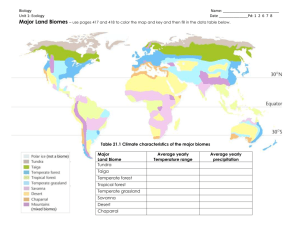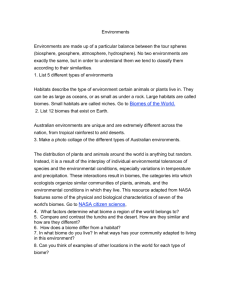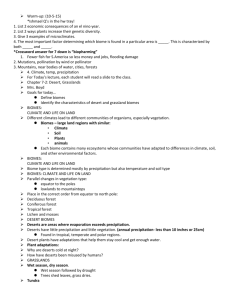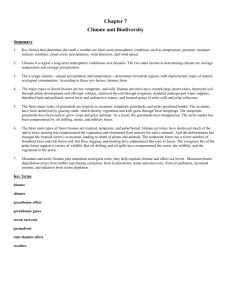ESS Topic 2.4 - Biomes
advertisement
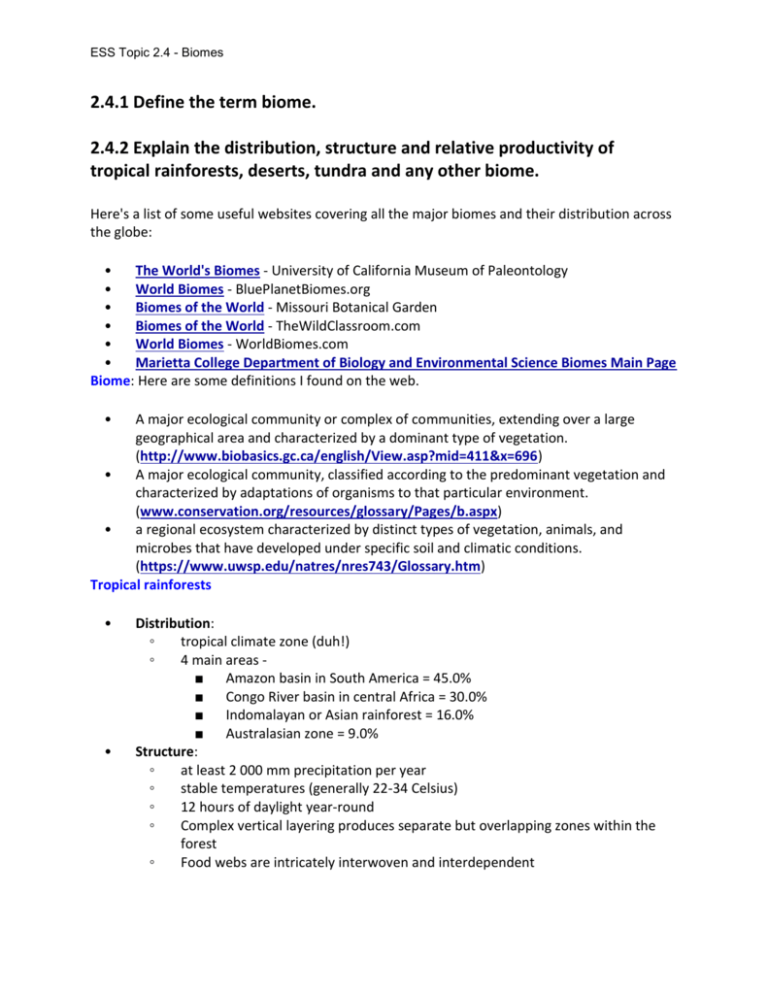
ESS Topic 2.4 - Biomes 2.4.1 Define the term biome. 2.4.2 Explain the distribution, structure and relative productivity of tropical rainforests, deserts, tundra and any other biome. Here's a list of some useful websites covering all the major biomes and their distribution across the globe: • The World's Biomes - University of California Museum of Paleontology • World Biomes - BluePlanetBiomes.org • Biomes of the World - Missouri Botanical Garden • Biomes of the World - TheWildClassroom.com • World Biomes - WorldBiomes.com • Marietta College Department of Biology and Environmental Science Biomes Main Page Biome: Here are some definitions I found on the web. • A major ecological community or complex of communities, extending over a large geographical area and characterized by a dominant type of vegetation. (http://www.biobasics.gc.ca/english/View.asp?mid=411&x=696) • A major ecological community, classified according to the predominant vegetation and characterized by adaptations of organisms to that particular environment. (www.conservation.org/resources/glossary/Pages/b.aspx) • a regional ecosystem characterized by distinct types of vegetation, animals, and microbes that have developed under specific soil and climatic conditions. (https://www.uwsp.edu/natres/nres743/Glossary.htm) Tropical rainforests • • Distribution: ◦ tropical climate zone (duh!) ◦ 4 main areas ■ Amazon basin in South America = 45.0% ■ Congo River basin in central Africa = 30.0% ■ Indomalayan or Asian rainforest = 16.0% ■ Australasian zone = 9.0% Structure: ◦ at least 2 000 mm precipitation per year ◦ stable temperatures (generally 22-34 Celsius) ◦ 12 hours of daylight year-round ◦ Complex vertical layering produces separate but overlapping zones within the forest ◦ Food webs are intricately interwoven and interdependent ESS Topic 2.4 - Biomes ◦ poor quality soils (low nutrients) because nutrients are contained in the tree biomass • Relative productivity: ◦ Extremely high productivity due to year-round photosynthesis, stable temperature and precipitation. ◦ Biomass is concentrated in woody tissue of trees (i.e. most of the biomass in the rainforest is in the producers) • References: ◦ http://rainforests.mongabay.com Deserts • • • • Distribution: ◦ tropical and temperate climate zones ◦ Hot deserts: ■ Africa (Sahara in the north, Namib and Kalahari in the south) ■ Arabian peninsula ■ Australia ◦ Temperate deserts: ■ Central Asia (Gobi in Mongolia and China) ■ western USA (Sonora) ◦ Coastal deserts: ■ west coast of South America (Atacama in Chile and Peru) Structure: ◦ evaporation exceeds precipitation - that's why they're dry! ◦ less than 50 mm precipitation annually ◦ average temperature 20-25 Celsius (includes both night and day) but will reach extremes of both hot and cold 12 - 49 Celsius ◦ drought-tolerant plant species ◦ rodents and other small mammals, insects, reptiles, & birds are predominant fauna Relative productivity ◦ low productivity References: ◦ University of Edinburgh, Scotland - desert biome ◦ Biology Pages at Ultranet by J. Kimball ◦ Energy Flow and Community Structure in Deserts - Earlam University ◦ University of California Museum of Paleontology - desert biome Tundra • Distribution: ◦ polar climate zone ◦ northern hemisphere ONLY (no land in corresponding latitudes of southern hemisphere) ◦ Alaska, Canada, Scandinavia, Russia ESS Topic 2.4 - Biomes • Structure: ◦ frozen ground (permafrost) prevents deep root penetration ◦ low nutrient content in soil due to minimal biological activity during long winters ◦ short plants due to frozen ground and nutrient shortage ◦ windy! ◦ lichens, mosses, and heaths - no trees ◦ mammals predominate; no reptiles or amphibians due to cold climate • Relative productivity: ◦ low productivity • References: ◦ Marietta College Tundra page ◦ Biology Pages at Ultranet by J. Kimball Taiga (northern coniferous forest) • Distribution: ◦ polar climate zone ◦ Alaska, Canada, northern Europe and northern Asia ◦ south of the tundra biome • Structure: ◦ harsh, long, cold winters; relatively cool summers ◦ long nights (winter) long days (summer) ◦ precipitation falls throughout the year - snow melt provides much water for flora ◦ dominant vegitation is coniferous trees (Fir, spruce, pine species), mosses, grasses, & lichens ◦ thin, nutrient-poor soil due to cold ◦ acidic soil from evergreen needles • Relative productivity: ◦ relatively low, but large insect and bird migrations with seasons ◦ rodents and mammals dominate fauna ◦ low diversity • References: ◦ ICSU Scope 56 - Coniferous Forests, Grasslands, and Savanna ◦ Biology Pages at Ultranet by J. Kimball ◦ Wikipedia Taiga page Temperate deciduous forest • • Distribution: ◦ temperate climate zone ◦ eastern North America, western Europe, China, Korea, Japan, Australia Structure: ◦ precipitation falls throughout the year ◦ distinct summer and winter seasons with fluctuations in temperature and day length ◦ layers within the forest - large trees, small understory trees, shrubs, ground zone ESS Topic 2.4 - Biomes • Relative productivity: ◦ high - 2nd highest after tropical rainforest ◦ well-developed food webs ◦ productivity fluctuates with seasons • References: ◦ Biology Pages at Ultranet by J. Kimball ◦ Mariette College Temperate forest page Prairies (temperate grasslands) • Distribution: ◦ temperate climate zone ◦ north America (plains states), south America (Argentina), Africa (Zimbabwe), central Asia • Structure: ◦ less than 10% tree cover ◦ dominant vegetation is grasses ◦ deep, rich, high-quality soil with lots of nutrients ◦ humid; seasonal precipitation • Relative productivity: ◦ relatively high ◦ high fauna diversity due to large amount of producers supporting extensive food webs - lots of grazing animals • References: ◦ ICSU Scope 56 - Coniferous Forests, Grasslands, and Savanna ◦ Biology Pages at Ultranet by J. Kimball Savannas • • • • Distribution: ◦ tropical climate zone ◦ Africa, South America, India, Australia, parts of SE Asia (Burma, Thailand) Structure: ◦ 235 - 1 000 mm precipitation annually ◦ distinct wet and dry seasons with long periods of drought ◦ scattered shrubs and isolated trees ◦ warm throughout the year ◦ plants adapted for drought ◦ animals adapted for running (long legs, good eyesight) Relative productivity: ◦ relatively high - grasses and shrubs provide ample food for well-developed food webs References: ◦ ICSU Scope 56 - Coniferous Forests, Grasslands, and Savanna ◦ Encyclopedia Brittanica ◦ PlantzAfrica.com ESS Topic 2.4 - Biomes ◦ BluePlanetBiomes.org Chaparral (Scrub forest) • Distribution: ◦ temperate climate zone ◦ northern California, coastal zones surrounding Mediterranean Sea, central Chile, western and southern Australia • Structure: ◦ 300 - 1 000 mm precipitation annually ◦ mild wet winters, hot dry summers ◦ stable temperatures year-round ◦ soil is thin, poor quality, rocky, and usually steep ◦ prone to wildfires ◦ plants adapted to drought • Relative productivity: ◦ dense populations of trees and shrubs ◦ medium-to-low productivity restricted by poor soil and seasonal precipitation ◦ fauna is mostly small mammals, birds, and insects; not many large animals • References: ◦ Biology Pages at Ultranet by J. Kimball ◦ Wikipedia chaparral page Coral reefs • Distribution: ◦ tropical climate zones ◦ eastern coasts of Australia, Africa, central America, Oceania (Malaysia, Indonesia) • Structure: ◦ warm, shallow water (less than 25 m) because sunlight required for photosynthesis ◦ algae and phytoplankton form foundation of coral reef food chain ◦ densely populated with corals and fish (fauna) ◦ salinity levels also dictate location ◦ wave action provides oxygen and helps clean the reef • Relative productivity: ◦ high - very diverse; compared to "rainforests of the sea" • References: ◦ Texas A&M University coral reef page Estuaries • • • Distribution: Structure: Relative productivity: ESS Topic 2.4 - Biomes • References: Lakes & Rivers • • • Distribution: Structure: Relative productivity:




